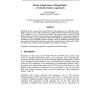Free Online Productivity Tools
i2Speak
i2Symbol
i2OCR
iTex2Img
iWeb2Print
iWeb2Shot
i2Type
iPdf2Split
iPdf2Merge
i2Bopomofo
i2Arabic
i2Style
i2Image
i2PDF
iLatex2Rtf
Sci2ools
ENTER
2009
Springer
2009
Springer
On the Importance of Hyperlinks: A Network Science Approach
Hyperlinks are the essence of the World Wide Web. Their importance is very high due to their ability to provide a visitor with a wealth of good quality information and for the role they play in the ranking of sites by modern search engines. This paper provides a network science approach to provide evidence to the importance of hyperlinking. We examine the webgraph of a tourism destination using graph theoretic methods to highlight the effects that the topological structure has on its navigability. Moreover, through a series of simulations performed on the representation of the real web network we show how a modest increase in the number of links may improve the visibility and the navigability of the destination’s webspace.
Related Content
| Added | 24 Jul 2010 |
| Updated | 24 Jul 2010 |
| Type | Conference |
| Year | 2009 |
| Where | ENTER |
| Authors | Rodolfo Baggio, Magda Antonioli Corigliano |
Comments (0)

